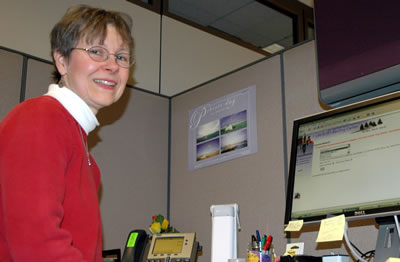By Lisa Yang

Pam Newsome, librarian and management analyst for 23 years, recently took the business ethics class, one of seven mandatory training classes offered through the Office of Human Resources. Photo by Craig Wilkins |
This year, Mn/DOT will teach employees how to drive more safely, act more ethically and navigate an ever-changing working environment more successfully as part of seven mandatory training courses offered through the Office of Human Resources.
Pam Newsome, librarian and management analyst for 23 years, recently took the business ethics class and found useful information and clarifications about Mn/DOT’s ethics policy.
“It went into great detail,” said Newsome. “Most of it is common sense, but it also goes through whether it’s okay to participate in prize drawings or accept gifts, and covers other conflicts of interest.”
Along with business ethics, six other courses are currently required: new employee orientation, defensive driving, drug and alcohol policy education, appropriate and secure use of electronic equipment, national incident management system and diversity. Each class has a different timeframe for completion. Training representatives are responsible for making sure employees get the training they need and that training records are established and kept for all employees.
The mandatory classes stem from the needs identified annually by the agency.
“Around the beginning of the fiscal year, Mn/DOT’s Office of Human Resources takes a look at what courses can be added or deleted,” said Tony Cairns, employee capability management systems administrator. “Decisions are tied to legal mandates, funding program requirements and senior management’s business priorities for Mn/DOT.
“Defensive driving, for example, is mandatory because many employees drive DOT vehicles,” said Cairns. “By having employees take the training, it helps reduce insurance costs, reduce the number of accidents and reinforces safety practices, such as wearing seat belts.”
Training is offered online and in classroom sessions, depending on the course. Training that is taken and finished online will automatically be added to employees’ training records.
“The online training is very convenient and took me about 50 minutes to complete,” said Newsome. “You can page back and forth during the training, and it’s easy to go back and review.”
Since February 2009, 2,352 employees have taken and completed at least one course.
To enroll in a class, contact your training representative or administrative manager.
For further information about the courses, contact Linda Hinrichs at 651-366-5244 or Linda.hinrichs@dot.state.mn.us.
Craig Wilkins contributed to this article.
|



